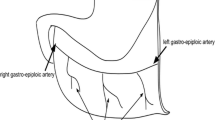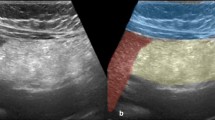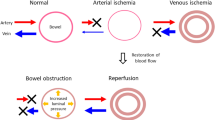Abstract
Background
The aim of this study is to describe contrast-enhanced computed tomographic (CT) features of acute omental infarction and to study the evolutionary changes on follow-up CT imaging.
Methods
Fifteen cases of omental infarction were evaluated for their initial CT imaging features. The imaging features evaluated included size of the fatty lesion, location, peripheral rim, and relation to colon. CT findings were correlated with etiology, clinical presentation, and leukocytosis. Follow-up CT images were available in eight patients and the imaging features were studied.
Results
Eight omental infarcts were of unknown etiology and seven were secondary to abdominal surgery. In 53% of patients (eight of 15), the location of the omental infarct was in the right lower, mid, or upper quadrants. These eight right-side infarcts occurred in six patients with primary omental infarcts. In 13 of 14 patients who underwent CT within 15 days of onset of omental infarct, the margin of the lesion was ill defined. Primary omental (n = 8) infarcts were seen in younger patients (p = 0.02) and were larger on CT (p = 0.02) compared with secondary omental infarcts. CT findings evolved from an ill-defined, heterogeneous fat-density lesion to a well-defined, heterogeneous fat-density lesion with a peripheral hyperdense rim in all six secondary omental infarctions for which acute stage and follow-up CT images were available for interpretation.
Conclusion
There is a significant difference in the age distribution and CT findings in terms of size of the omental infarction between primary and secondary etiologies. On follow-up CT, secondary omental infarcts progressively shrank and developed a well-defined, hyperdense rim around a fatty core.



Similar content being viewed by others
References
Puylaert JB, (1992) Right-sided segmental infarction of the omentum: clinical, US, and CT findings. Radiology 185:169–172
Miguel Perello J, Aguayo Albasini JL, Soria Aledo V, et al. (2002) Omental torsion: imaging techniques can prevent unnecessary surgical interventions. Gastroenterol Hepatol 25:493–496
van Breda Vriesman AC, Lohle PN, Coerkamp EG, Puylaert JB (1999) Infarction of omentum and epiploic appendage: diagnosis, epidemiology and natural history. Eur Radiol 9:1886–1892
Bush P (1896) A case of hemorrhage into the greater omentum. Lancet 1:286
Singh AK, Gervais DA, Hahn PF, et al. (2004) CT appearance of acute appendagitis. AJR 183:1303–1307
Singh AK, Alhilali LM, Gervais DA, Mueller PR (2004) Omental infarct: an unusual CT appearance after superior mesenteric artery occlusion. Emerg Radiol 10:276–278
Phillips RW, Peterson CM (1988) Infarction of the omentum after cesarean section. A case report. J Reprod Med 33:382–384
Schwartzman GJ, Jacobs JE, Birnbaum BA (2001) Omental infarction as a delayed complication of abdominal surgery. Clin Imaging 25:341–343
Hollerweger A, Rettenbacher T, Macheiner P, Gritzmann N (1996) Spontaneous fatty tissue necrosis of the omentum majus and epiploic appendices: clinical, ultrasonic and CT findings. Rofo Fortschr Geb Rontgenstr Neuen Bildgeb 165:529–534
Garant M, Taourel P, Fried GM, Bret PM (1995) Thickening of the transverse colon associated with torsion of the greater omentum. AJR 165:1309
Helmrath MA, Dorfman SR, Minifee PK, et al. (2001) Right lower quadrant pain in children caused by omental infarction. Am J Surg 182:729–732
Kimber CP, Westmore P, Hutson JM, Kelly JH (1996) Primary omental torsion in children. J Paediatr Child Health 32:22–24
Vertuno LL, Dan JR, Wood W (1980) Segmental infarction of the omentum: a cause of the semi-acute abdomen. Am J Gastroenterol 74:443–446
Balthazar EJ, Lefkowitz RA (1993) Left-sided omental infarction with associated omental abscess: CT diagnosis. J Comput Assist Tomogr 17:279–381
Patchell RD (1977) A fatal case of idiopathic omental infarction. W Va Med J 73:29–30
Author information
Authors and Affiliations
Corresponding author
Additional information
An erratum to this article can be found online at http://dx.doi.org/10.1007/s00261-011-9711-3
Rights and permissions
About this article
Cite this article
Singh, A.K., Gervais, D.A., Lee, P. et al. Omental infarct: CT imaging features. Abdom Imaging 31, 549–554 (2006). https://doi.org/10.1007/s00261-005-0251-6
Received:
Accepted:
Published:
Issue Date:
DOI: https://doi.org/10.1007/s00261-005-0251-6




